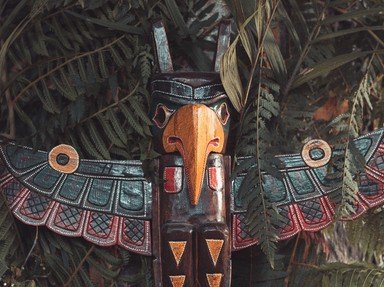Quiz Answer Key and Fun Facts
1. Curiously bent trees like this one can be found throughout many forested areas in the United States. What do some historians believe was one use for them?
2. Is it legal to hunt for, collect, and sell arrowheads in every state of the US?
3. Mounds like this one can be found in a number of places throughout the US. For what do scholars NOT believe that they were built?
4. These relics are not something that was created by Native Americans, but were created because of them. What institutions were created by the US government as a way to "Americanize" Native children?
5. What are Native American carvings on rocks, such as these, called?
6. In which area of the US is it common to find totem poles?
7. Which parts of an animal did Native Americans commonly use for some of their tools that were used for cutting or chopping?
8. What musical instrument, common across many Native American cultures, is usually made with animal skins and sinew?
9. How did many Native American women traditionally carry their infants when they were out walking or working in fields and forests?
10. Some animals, including the bison, were sacred to Native American peoples. What familial relationship do many Native Americans believe exists between the sacred animals and the people?
Source: Author
Trivia_Fan54
This quiz was reviewed by FunTrivia editor
ponycargirl before going online.
Any errors found in FunTrivia content are routinely corrected through our feedback system.
